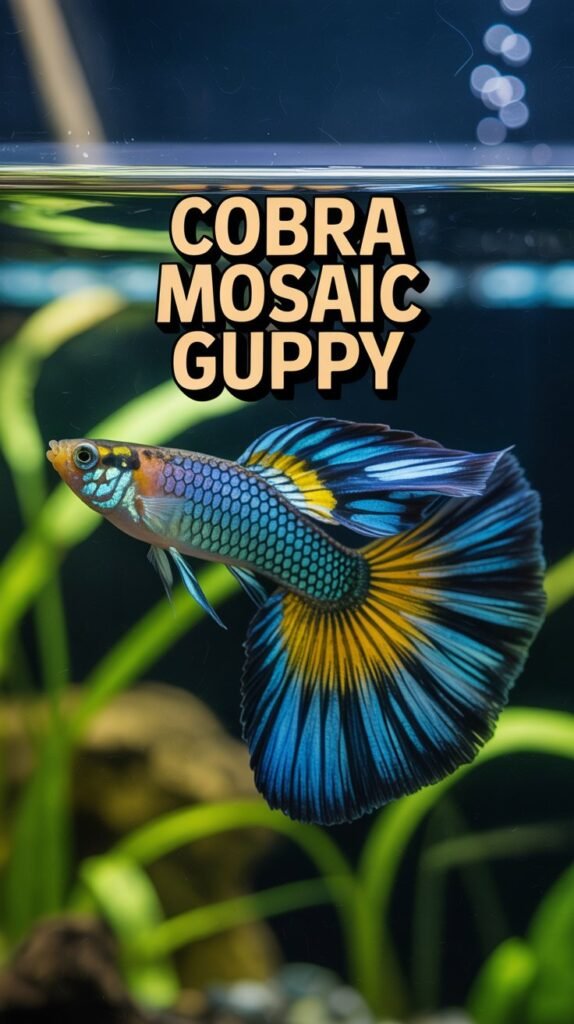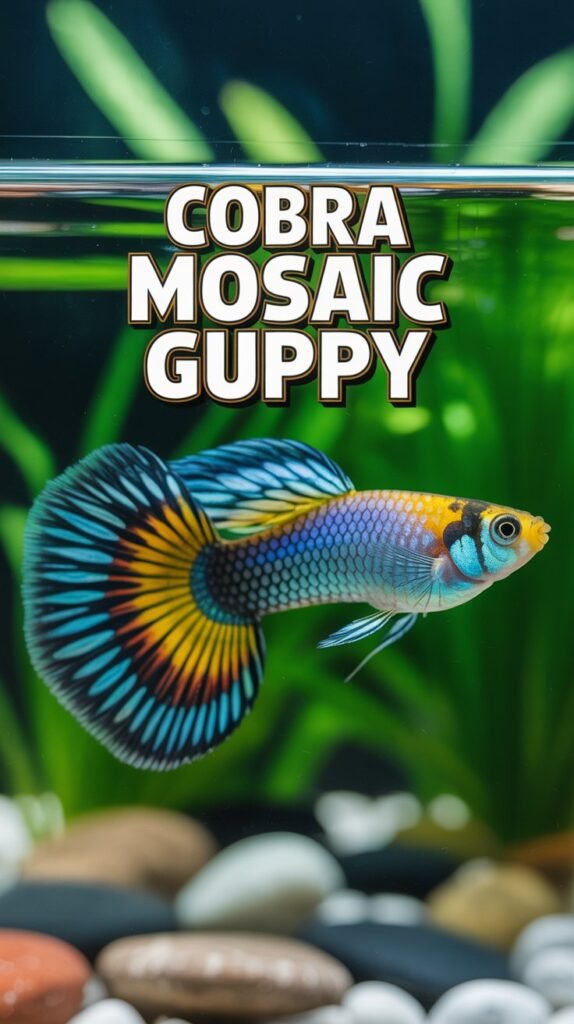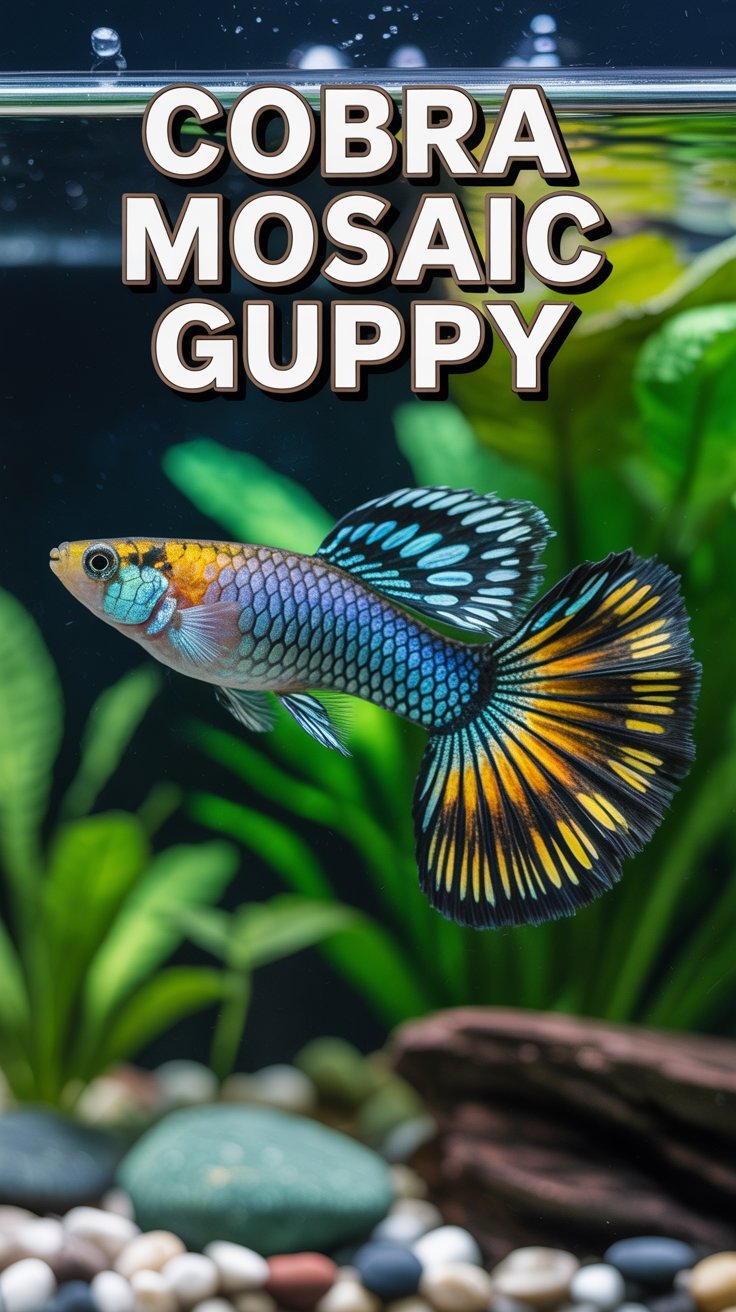The Cobra Mosaic Guppy is one of the most eye-catching and popular varieties of guppies in the aquarium world. Known for its intricate cobra-like body patterns and colorful mosaic tail, this guppy variety combines elegance, vibrance, and hardiness — making it a favorite among both beginners and experienced aquarists.
In this comprehensive guide, we’ll explore everything about Cobra Mosaic Guppies — from their origins and characteristics to care, breeding, feeding, and tank setup. Whether you’re looking to start a new guppy tank or expand your collection, this article will help you raise healthy and beautiful Cobra Mosaic Guppies.
1. Introduction to Cobra Mosaic Guppy
The Cobra Mosaic Guppy (Poecilia reticulata) is a selectively bred strain developed for its distinct combination of cobra body patterns and mosaic tail designs. The “cobra” part of its name comes from the wavy, serpentine lines and dots across its body that resemble a snake’s skin. The “mosaic” refers to the tail pattern — a beautiful mix of colors that creates a stained-glass effect.

These guppies are small, peaceful, and active swimmers. They bring a burst of color to any aquarium and are well-suited for community tanks. Because they’re adaptable and easy to care for, Cobra Mosaic Guppies are one of the best options for both novice and expert fish keepers.
2. Origin and History
Guppies originate from freshwater habitats in South America, particularly in countries like Venezuela, Trinidad, and Brazil. Over time, selective breeding has produced hundreds of color variations and tail types — one of which is the stunning Cobra Mosaic Guppy.
Breeders combined guppies with rich body markings (Cobra Guppy) and guppies with decorative tails (Mosaic Guppy) to produce this hybrid strain. The result is a guppy that displays the best of both worlds — complex cobra body patterns and a vivid, mosaic-like tail.
The Cobra Mosaic Guppy is now a globally popular strain, prized in both home aquariums and guppy competitions for its visual appeal and breeding potential.
3. Appearance and Characteristics
The Cobra Mosaic Guppy is easily identifiable thanks to its remarkable color combination and detailed body markings.
a. Body Pattern
The body features a distinctive network of dark, irregular lines resembling snake scales — the signature of the “cobra” pattern. These markings run from behind the gill plates to the base of the tail, adding depth and contrast to the fish’s overall appearance.
b. Tail Design
The “mosaic” tail is large, flowing, and filled with overlapping patches of color that create a stained-glass effect. The tail often displays shades of red, blue, orange, black, and yellow in mesmerizing patterns.
c. Size
Adult males usually grow to about 1.5 inches (3.8 cm), while females can reach up to 2.5 inches (6 cm). The males are smaller but more colorful, while females are larger with subtler coloration.
d. Sexual Dimorphism
- Males: Bright colors, smaller bodies, and long flowing tails.
- Females: Larger bodies, rounder bellies, and less vivid coloration.
e. Lifespan
With proper care, Cobra Mosaic Guppies can live for 2 to 3 years, though some may reach 4 years in optimal conditions.
4. Behavior and Temperament
Cobra Mosaic Guppies are peaceful, social, and highly active. They thrive in groups and enjoy swimming in all areas of the tank. Their friendly nature makes them ideal community fish that coexist well with other non-aggressive species.
However, males may occasionally show mild aggression when competing for females during breeding. Keeping a proper male-to-female ratio (1 male for every 2–3 females) helps reduce stress and maintain harmony in the tank.
These guppies are also curious and responsive to their environment. They often swim toward the glass when you approach, making them a delight to observe.
5. Ideal Tank Setup for Cobra Mosaic Guppies
To bring out the best in your Cobra Mosaic Guppies, setting up a well-balanced and comfortable tank is essential.
a. Tank Size
A minimum of 10 gallons is suitable for a small group of guppies. However, a 20-gallon tank or larger provides better space for swimming and breeding.
b. Water Parameters
Cobra Mosaic Guppies are hardy but prefer stable water conditions:
- Temperature: 72–82°F (22–28°C)
- pH Level: 6.8–7.8
- Hardness: 8–12 dGH
- Ammonia/Nitrite: 0 ppm
- Nitrate: < 20 ppm
c. Filtration and Aeration
A gentle sponge filter or hang-on-back filter works best for guppies. They require clean, oxygen-rich water, so maintaining regular filtration and moderate water flow is key.
d. Lighting
Moderate lighting enhances their colors and supports plant growth. Avoid overly bright lighting as it can stress the fish.
e. Substrate and Decorations
Use a fine gravel or sand substrate. Add decorations like driftwood, rocks, and live plants such as Java Moss, Anubias, and Hornwort to create hiding spots and mimic their natural habitat.
f. Plants
Cobra Mosaic Guppies appreciate planted tanks. Floating plants like Duckweed and Amazon Frogbit also provide shade and comfort.
6. Diet and Feeding
Cobra Mosaic Guppies are omnivorous and enjoy a varied diet. A balanced feeding routine enhances their color, vitality, and breeding success.
a. Recommended Foods
- High-quality flakes or micro pellets (as staple food)
- Frozen or live foods: Brine shrimp, daphnia, mosquito larvae, bloodworms
- Vegetable matter: Blanched spinach, zucchini, or algae wafers
Feed small portions twice a day — only what they can consume within 2 minutes. Overfeeding can lead to poor water quality and health issues.
b. Color Enhancement
To maintain the vivid colors of your Cobra Mosaic Guppy, incorporate natural color-enhancing foods like spirulina and krill-based products.
7. Breeding Cobra Mosaic Guppies

Cobra Mosaic Guppies are livebearers, meaning females give birth to live fry instead of laying eggs. Breeding them is relatively easy with the right setup.
a. Breeding Conditions
- Tank Size: At least 10 gallons for breeding pairs
- Temperature: 78–80°F (25–27°C)
- Lighting: 10–12 hours daily
Provide plenty of plants or breeding grass where fry can hide immediately after birth.
b. Mating Process
The male uses his gonopodium (a modified fin) to fertilize the female internally. The gestation period lasts about 25–30 days.
c. Fry Care
After birth, separate the fry from adults, as adult guppies may eat them. Feed the fry infusoria, baby brine shrimp, or crushed flakes several times a day.
Within 4–6 weeks, the fry start developing colors and patterns.
8. Common Diseases and Prevention
Like all aquarium fish, Cobra Mosaic Guppies can suffer from diseases if the water quality is poor or if they are stressed.
Common Diseases
- Ich (White Spot Disease) – White grains on the body and fins.
Treatment: Raise temperature slightly and use aquarium salt or Ich medication. - Fin Rot – Frayed fins caused by bacterial infection.
Treatment: Maintain clean water and use antibacterial medication. - Velvet Disease – Gold dust-like coating on skin.
Treatment: Dim lights and apply copper-based treatment. - Swim Bladder Disorder – Difficulty swimming or floating.
Treatment: Feed boiled, peeled peas and maintain a balanced diet.
Prevention Tips
- Regular water changes (25–30% weekly)
- Avoid overcrowding
- Quarantine new fish before adding them to the main tank
- Feed high-quality food in moderation
9. Tank Mates for Cobra Mosaic Guppies
Cobra Mosaic Guppies thrive in peaceful community tanks. Choose calm, non-aggressive species that won’t nip their fins.
Good Tank Mates
- Neon Tetras
- Corydoras Catfish
- Mollies
- Platies
- Swordtails
- Zebra Danios
- Cherry Shrimp
- Snails
Avoid aggressive species like Betta fish or fin-nippers such as Tiger Barbs.
10. Color Variations and Selective Breeding
Cobra Mosaic Guppies come in several color variations — red, blue, yellow, and multicolor. Through selective breeding, enthusiasts have created countless combinations, each with unique tail and body markings.
Selective breeding focuses on enhancing:
- Color vibrancy
- Tail size and shape
- Consistency in cobra pattern
- Fertility and fry survival rate
Advanced breeders often cross Mosaic and Cobra guppies to strengthen genetic traits and produce show-quality strains.
11. Maintenance and Cleaning
Keeping a clean environment ensures your Cobra Mosaic Guppies stay healthy and vibrant.
Routine Maintenance
- Weekly water changes: 25–30%
- Gravel vacuuming: Remove leftover food and waste
- Filter cleaning: Rinse in tank water, not tap water, to preserve beneficial bacteria
- Water testing: Monitor ammonia, nitrite, and nitrate levels
A consistent maintenance schedule prevents disease outbreaks and maintains stable water conditions.
12. Why Choose Cobra Mosaic Guppies
Here’s why the Cobra Mosaic Guppy stands out among other guppy strains:
- Unique Appearance: The blend of cobra body markings and mosaic tail creates a stunning visual appeal.
- Hardy and Adaptable: Tolerates a wide range of water conditions.
- Easy Breeding: Perfect for hobbyists interested in guppy genetics.
- Community Friendly: Peaceful nature makes them ideal for mixed aquariums.
- Active Swimmers: Always moving, bringing life to your tank.
Their versatility, beauty, and lively personality make them a top choice for aquarists worldwide.
13. Tips for Enhancing Color and Health
To ensure your Cobra Mosaic Guppies remain vibrant and active:
- Keep a stable water temperature between 75–80°F.
- Feed color-enhancing foods containing carotenoids and spirulina.
- Maintain a stress-free environment with hiding spots.
- Use a dark substrate to make their colors stand out.
- Keep lighting moderate to highlight tail patterns.
Healthy, stress-free guppies always display brighter and more intense colors.
14. Lifespan and Growth Factors
The average lifespan of Cobra Mosaic Guppies is 2–3 years, but with optimal care, they can live longer. Factors that influence lifespan include:
- Water quality
- Diet and nutrition
- Genetic health
- Stress levels
Providing consistent care, clean water, and a balanced diet significantly extends their life and enhances their reproductive success.
15. Conclusion
The Cobra Mosaic Guppy is a living piece of art — with its stunning cobra-like body patterns and dazzling mosaic tail. This guppy variety adds unmatched beauty and liveliness to any aquarium. Easy to care for, breed, and enjoy, it’s the perfect choice for anyone looking to experience the joy of keeping ornamental fish.
Whether you’re setting up your first guppy tank or refining your breeding line, the Cobra Mosaic Guppy will reward you with endless color, activity, and fascination.
FAQs about Cobra Mosaic Guppy
1. Are Cobra Mosaic Guppies easy to care for?
Yes, they are hardy and beginner-friendly. They adapt well to different water conditions and require minimal maintenance.
2. What do Cobra Mosaic Guppies eat?
They eat flakes, pellets, and live or frozen foods such as brine shrimp, daphnia, and bloodworms. A varied diet enhances their color and health.
3. How can I tell male and female Cobra Mosaic Guppies apart?
Males are smaller and more colorful with longer tails, while females are larger, duller, and have rounder bellies.
4. How often do Cobra Mosaic Guppies breed?
Females can give birth every 4–6 weeks, producing 20–50 fry per batch under ideal conditions.
5. Can Cobra Mosaic Guppies live with other fish?
Yes, they coexist peacefully with small, non-aggressive species like tetras, mollies, and corydoras.
6. How do I prevent diseases in Cobra Mosaic Guppies?
Keep water clean, avoid overfeeding, quarantine new fish, and perform regular water changes.
7. Do Cobra Mosaic Guppies need a heater?
Yes, maintaining a stable warm temperature (around 75–80°F) helps them stay healthy and active.
8. How long do Cobra Mosaic Guppies live?
They typically live 2–3 years, but with excellent care, they can live up to 4 years.

